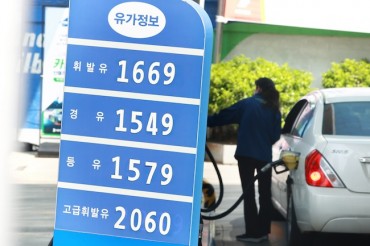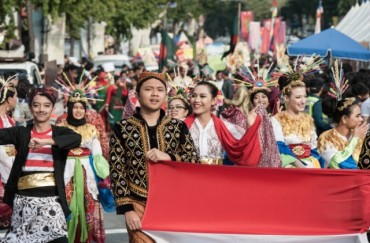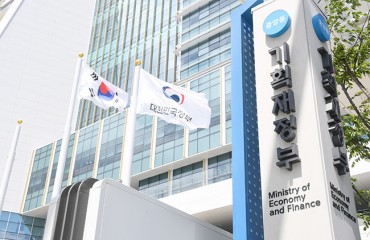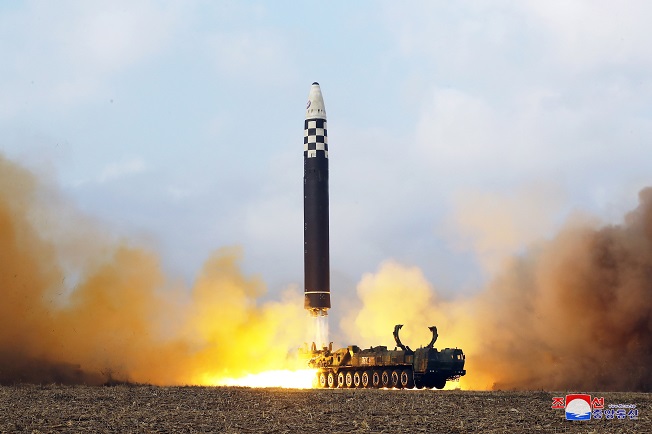
North Korea fires an intercontinental ballistic missile, in this file photo released by its state media on Nov. 19, 2022. (Yonhap)
SEOUL, Dec. 16 (Korea Bizwire) — As a turbulent year in regional security, dotted with North Korea’s frantic missile launches amid stalled dialogue and complex geopolitics, draws to a close, uncertainty still looms large on the Korean Peninsula.
This year, the Kim Jong-un regime fired more than 60 ballistic missiles into the ocean, a single-year record, while codifying an aggressive nuclear policy, shunning diplomacy with Seoul and Washington, and asserting a principle of “power for power and head-on contest.”
There is no sign of any breakthrough in efforts to restart denuclearization talks and inter-Korean exchanges. The North has not concealed its hostile stance toward the South’s conservative administration of Yoon Suk-yeol, which was launched in May.
Outside the peninsula, instability from Russia’s war in Ukraine, an intensifying Sino-U.S. rivalry and perceived inaction by the U.N. Security Council (UNSC) have dampened hopes for international cooperation in curbing North Korean provocations.
As the new year approaches, few foresee auspicious signs that Pyongyang will cease its saber-rattling and return to dialogue with the Washington-Beijing ties thawing to help facilitate inter-Korean reconciliation.
“Given the number of North Korean missile launches this year, it is fair to say the inter-Korean relationship has dipped to one of its lowest ebbs,” Kim Yeoul-soo, a senior researcher at the Korea Institute for Military Affairs, said.
“A shift in cross-border ties may hinge on the North’s course of action, but for now, it is difficult to predict if any turnaround will emerge next year.”
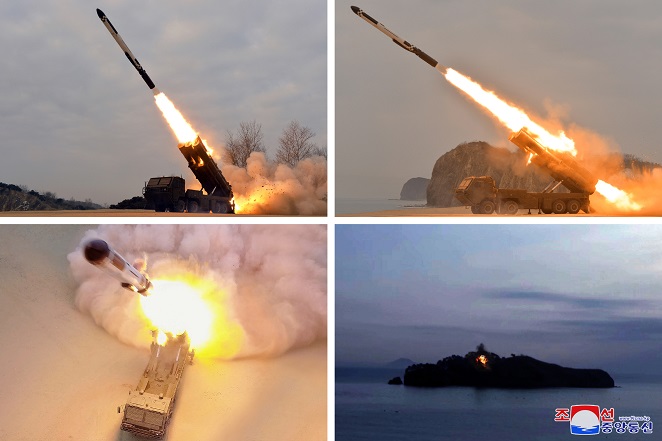
This composite photo, released by North Korea’s official Korean Central News Agency, shows a long-range cruise missile being test-fired on Jan. 25, 2022. (Yonhap)
Amid pandemic-driven curbs, the North has continued to remain insular throughout the year, while doubling down on its weapons development projects, including its push to secure “tactical” battlefield nuclear weapons.
The regime’s continued missile tests have highlighted its drive to secure reliable, diverse nuclear delivery vehicles as seen in the launches of hypersonic missiles, submarine-launched ballistic missiles and advanced short-range ones capable of “pull-up” maneuvers to avoid interception.
It has also forged ahead with a push to master intercontinental ballistic missile (ICBM) technologies through multiple tests, including last month’s test of a new Hwasong-17 ICBM deemed capable of traveling 15,000 kilometers, enough to cover the U.S. mainland.
This year alone, the North has test-fired eight ICBMs.
To secure the survivability of those weapons, the North has also focused on developing novel launch platforms, such as a reservoir silo and train, not to mention transporter erector launchers (TELs).
The reclusive state has justified its weapons tests as the exercising of what it calls its “inviolable right to self-defense” and shifted the blame to the United States’ “hostile” policy and its combined regular drills with the South.
The North’s nuclear ambitions appeared to have jelled further amid Russia’s war in Ukraine — a grim reminder of global power politics that could render a security pact vulnerable or invalid.
Russia invaded the former Soviet republic in February despite the 1994 Budapest Memorandum under which Moscow, along with Washington and London, pledged to offer security assurances to Ukraine in return for its handover of Soviet-era nuclear arms.
“The North might have already started to dismiss the idea of denuclearization in 2014, when Crimea was annexed by Russia, and Russia’s invasion of Ukraine might have further reinforced the North’s belief that it should go its own way,” said Kim Tae-hyung, professor of political science at Soongsil University.
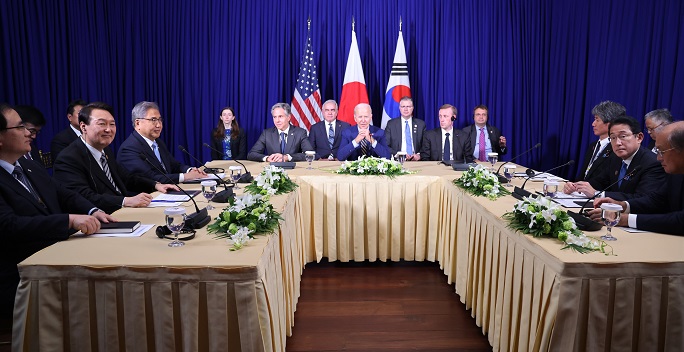
South Korean President Yoon Suk-yeol (far L), U.S. President Joe Biden (C) and Japanese Prime Minister Fumio Kishida (far R) pose for a photo during a trilateral summit in Phnom Penh on Nov. 13. (Yonhap)
Russia’s invasion boded ill for the South’s drive to rally global cooperation to address the North’s nuclear quandary as it spurred an apparent geopolitical realignment marked by rival blocs — authoritarian and democratic ones.
A sense of geopolitical division grew keener in May when the U.S.-led Indo-Pacific Economic Framework (IPEF) — seen as a move to counter China’s regional influence — was launched with the participation of the South, Japan and other countries.
Division has also been a worrisome hallmark of the UNSC that failed to produce a united front in toughening sanctions against the North for its continued ballistic missile provocations.
The North’s nuclear drive drew renewed attention in September when it codified an assertive nuclear policy that leaves open the possibility of a preemptive strike in case of a security threat to the regime.
In response, the South’s defense ministry warned any attempt at nuclear use would lead to Pyongyang’s “self-destruction.”
In its Nuclear Posture Review released in October, the U.S. said any nuclear attack by the North against the U.S. or its allies will result in the “end of that regime.”
The Yoon government has been stepping up security cooperation with Washington.
It has “normalized” scaled-back or suspended allied military drills and resumed a key security dialogue, called the Extended Deterrence Strategy and Consultation Group.
Seoul has also moved to restore security cooperation with Tokyo despite historical tensions, and sought to strengthen a trilateral security partnership with the U.S. and Japan.
In a sign of improving tripartite efforts, Yoon, Biden and Japanese Prime Minister Fumio Kishida announced their intention to share missile warning data “in real time” to address North Korean threats during their talks on the margins of a regional forum in Cambodia last month.
Apart from the security front, the Yoon administration also extended an olive branch to the North with the “audacious” initiative to help the impoverished state improve its economy in return for denuclearization steps. But the North dismissed the initiative as the “height of absurdity.”
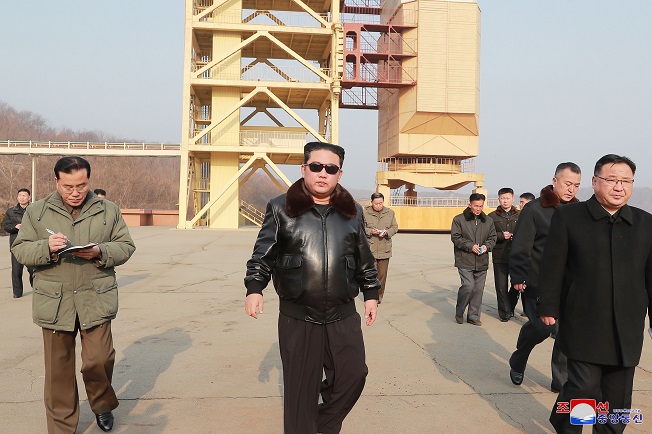
North Korean leader Kim Jong-un visits the Sohae Satellite Launching Ground on the country’s west coast, in this photo released on March 11, 2022 by the North’s official Korean Central News Agency. (Yonhap)
Just weeks away from the start of the new year, few seem to anticipate the emergence of a fresh momentum to reengage with the North, particularly against the backdrop of growing geopolitical tensions.
“As the confrontational ambience of the great-power rivalry continues into next year, uncertainties in the security landscape may further deepen,” Nam Chang-hee, professor of political science at Inha University, said.
“There seem to be no signs yet of any future turnaround in the overall environment.”
Some observers believe the North’s extraordinary weapons tests this year could have a silver lining as they could be part of the country’s tactics to bolster bargaining power before returning to the negotiating table.
In 2018, the North resumed engagement with the South and the U.S. on the back of the PyeongChang Winter Olympics, after its sixth nuclear experiment and a series of missile launches the previous year.
Park Won-gon, professor of North Korea Studies at Ewha Womans University, said that even if the North comes out for dialogue, there could be a caveat: It may want dialogue for an arms reduction or just a partial denuclearization rather than for the goal of the “complete denuclearization” pushed by Seoul and Washington.
Should the North press ahead with what would be its seventh nuclear test in the new year, it would set off “stronger-than-usual” reactions from the South and the U.S., and bring in a period of renewed tensions, analysts said.
What’s worrisome is that Pyongyang has technical imperatives to stage another nuclear test to master technologies to make warheads smaller and lighter.
(Yonhap)



